Gardening is an art form that connects us to the earth, offering us a kind of solace that also yields rewards like vegetation, crop, aroma, and beauty. Yet, Mother Nature constantly reminds us of her unpredictable temperament, capable of putting our gardens through the most demanding of tests. To ensure our green spaces survive these challenges, we must know how to protect them. After all, many storms can be untimely, meaning that you won’t be able to research the storm before it hits your garden.
One of the best ways to prepare before a severe weather disaster strikes is by investing in your very own little weather station. The last thing you want is to be caught off guard and scrambling to find a way to save your plants. Ideally, you’ll want a device that gives you readings such as temperature, humidity, barometric pressure, rainfall, wind speed, and wind direction, as this information will help you keep a protective watch over your garden with reliable results. However, before knowing the weather, know your plants. Some plants are naturally storm-hardy, while others are pretty delicate. By understanding the needs and tolerances of your plants, you can prioritize which ones need the most protection.
How to protect against thunderstorms, floods, and water woes
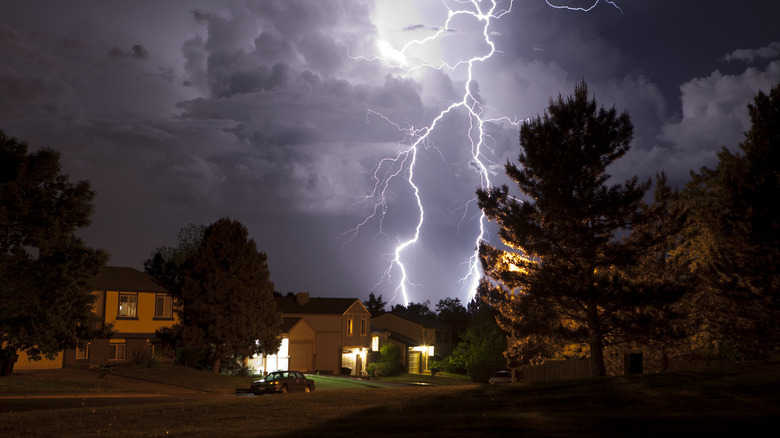
Perhaps the most common of heavy storms is a thunderstorm. Indeed, they are a sight to behold with their magnificent displays of lightning and powerful rainfall. For gardeners, this could spell potential trouble as these storms can deliver a flood which can lead to poor drainage, impact, and root rot. If you want to avoid the problems that come with floods altogether, a well-draining garden bed would protect the roots. It would also be a good idea to start incorporating organic matter like compost, mulch, or well-rotted manure, as this will help improve soil structure and allow it to efficiently drain excess water.
Also adjust things like gutters and downspouts to ensure that they flow water away from vulnerable areas and not towards them. Those who live in flood-prone areas may want to switch their garden over to a raised garden bed, which will elevate the plants from any pooling water. Another method worth trying if you have young seedlings or delicate plants involves setting a row cover of fabric over the top of your garden and securing it with stakes or landscaping pegs. This will ultimately help prevent the rain from damaging delicate plants and carving out your soil where seedlings may be growing.
Keeping plants safe in windstorms
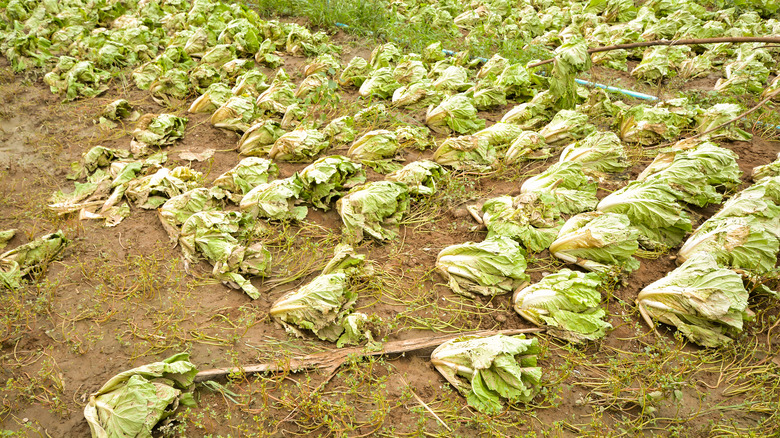
Heavy winds can do significant damage, and if they become awe-inspiring and terrifying tornadoes and hurricanes, they could completely destroy a garden. For more common windstorm scenarios, or those that exceed 34 miles per hour, the damage can vary from delicate plants stripped of their foliage to taller trees uprooting or breaking and harming almost everything in their path. While you cannot stop the winds, you can prepare. You’ll want to use stakes for taller plants or those with heavy blooms and ensure they’re securely anchored to prevent them from snapping or being uprooted. If you have any garden structures such as trellises and greenhouses, they should be firmly anchored as well for apparent reasons.
For those with smaller plants and gardens, all that would be necessary is to place a bucket over each plant and put something heavy on top to weigh it down, like a brick. It’s as easy as setting up anything that will obstruct the wind. If you’re a serious gardener with lots of ground to cover, you will probably want to consider putting together a living windbreak. Also known as a shelterbelt or hedge, this is a series of strategically-planted trees and shrubs designed to shield a specific area from strong winds. There are several additional benefits that come with a living windbreak like reduced soil erosion and more habitat for wildlife.
Protect your plants against the icy grip of a hail or snowstorm
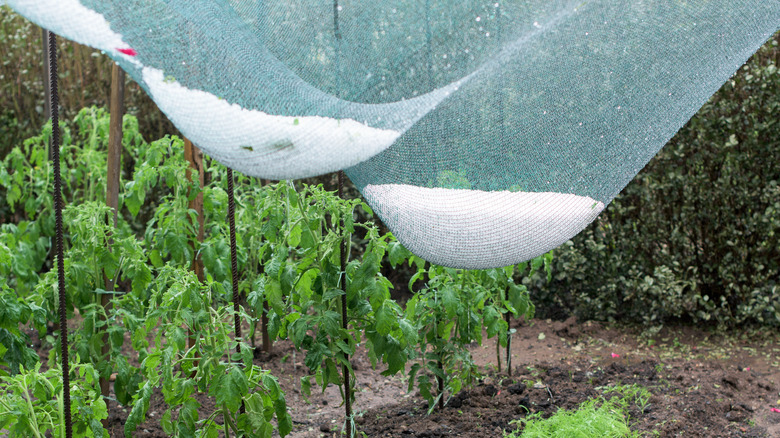
tchara/Shutterstock
For garden enthusiasts, hail and snow aren’t just atmospheric events but threats to months of hard work and dedication. For those with smaller gardens, the standard protective measures against these storms are similar to a windstorm scenario, using upturned buckets as shields. If your surface area is more extensive, consider incorporating hail netting, a commercial mesh, or a wire structure designed to deflect hailstones. These are great as they can also keep flying pests or predators at bay. Decide whether or not you would like this netting to be a permanent structure or something that’s stored close by in case of an unforeseen storm.
The same goes for a snowstorm, as the cold and moisture can have lasting impacts on your plants. Try putting burlap screens around more vulnerable plants to deter direct snow accumulation and mitigate the effect of wind-driven snow. If your garden is sizable and in a snow-prone area, add fencing to redirect or minimize snow drifts. Layered planting can also be a strategy against snow; let the hardier plants bear the brunt, shielding their more delicate counterparts. Alternatively, growing plants in a greenhouse or using cold frames can help double as formidable barriers while regulating temperatures. But before you’re surprised by a sudden alert, ensure you have a heavy-duty tarp or temporary plywood covering stored nearby to serve as a quick protective shield.
Help your plants survive in heatwaves and drought
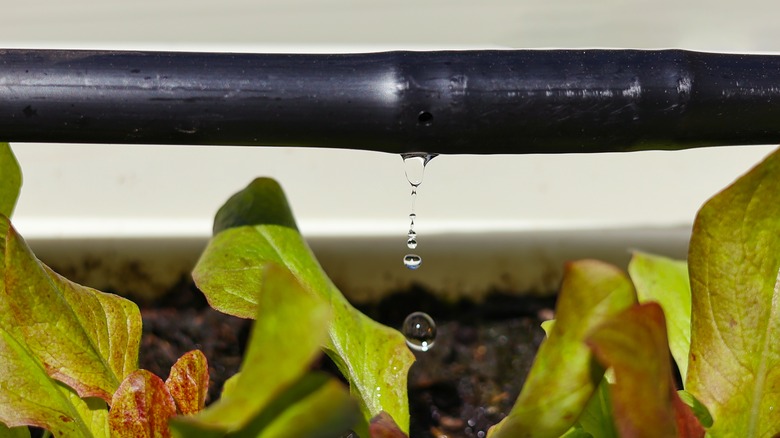
SrideeStudio/Shutterstock
There’s a fine line between a sunny day and a scorching heatwave. Prolonged hot temperatures can affect plants, causing them to wilt or even scorch, and combatting this requires a multi-pronged approach. Firstly, invest in shade nettings to shield plants from the sun’s intense rays and strategically place these around your plants during the hottest parts of the day. If your plants are in pots or containers, move them to shaded areas instead. Further, during extended dry spells, mulch will be your best friend. A thick layer of organic mulch that’s about 4 to 6 inches deep will help retain soil moisture, prevent water evaporation, and keep your plants cool.
Remember that watering should be done during the cooler parts of the day, like early morning or late evening, to reduce water loss from evaporation. In cases of extreme heat, water two to three times per week for even moisture. In the case of drought, which is essentially a longer-lasting heatwave, it’s important to follow specific water conservation methods to save your plants from completely drying out, like slowly weaning your plants off daily watering so that they can adjust to their new conditions. Another excellent investment to reinforce this control is a drip irrigation system, which can deliver water directly to the plant roots and reduce any water waste.
Dust storms versus your plants
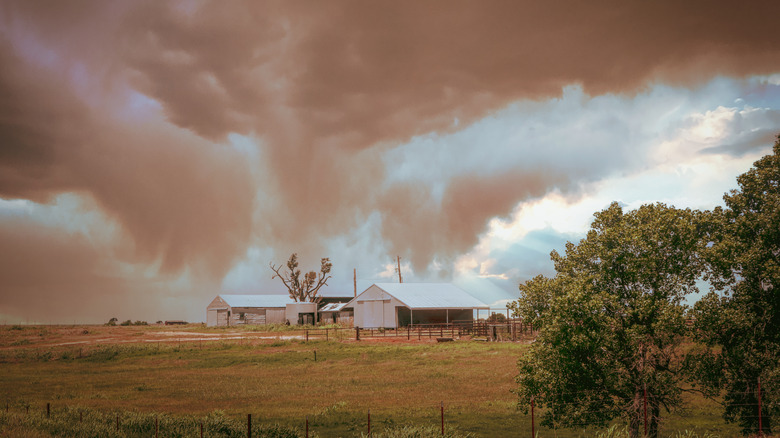
Susan Vineyard/Getty Images
Regions where dust storms prevail present gardens with a different challenge. These storms, characterized by solid winds carrying vast amounts of fine particles, can strip plants of their protective layers, bury small plants, and fill garden beds with debris. While one can’t fend off a dust storm’s intensity, one can create barriers.
Firstly, establishing a solid fence or wall around the perimeter of your garden can act as an initial line of defense against incoming dust. Natural barriers like thick hedges or shrubs can further trap and reduce the dust that makes it through to your garden. Placing a layer of gravel or large-sized mulch around your plants can reduce the soil’s exposure and prevent it from being picked up and carried away. Additionally, regular watering can help bind the soil and make it less susceptible to wind lift. After a dust storm, it’s essential to gently rinse off plants to remove the dust layer, ensuring the plant can breathe and undergo photosynthesis.



